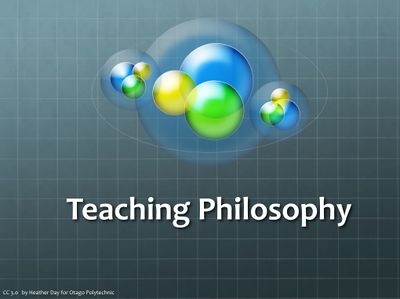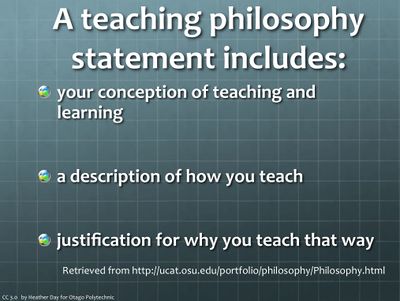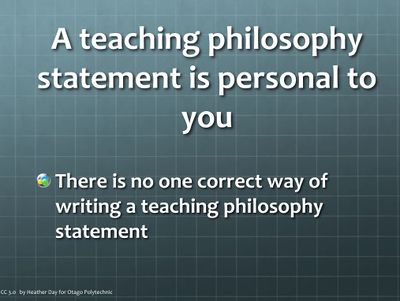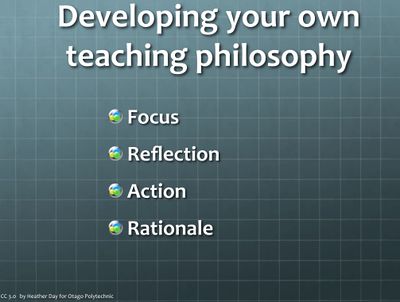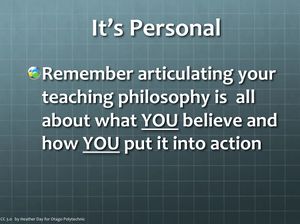Learner Centred Learning/LCL Teaching Philosophy Module
Contents
[hide]Teaching Philosophy
No, this page isn't about how to teach philosophy :-) It is all about exploring your own personal philosophy around being a teacher or facilitator of learning.
Your personal teaching philosophy is your beliefs and values around teaching. The challenge is being able to articulate your beliefs and provide rationale for the actions and choices that you make when facilitating others' learning.
A useful way of doing this is through creating your own teaching philosophy statement.
.
Teaching Philosophy Statement
The following statement outlines areas of key focus for such a statement.
Further to the above inclusions the University Center for the Advancement of Teaching at Ohio State University suggest that the statement can :
- demonstrate that you have been reflective and purposeful about your teaching
- communicate your goals as an instructor and your corresponding actions in the classroom
- provide an opportunity to point to and tie together the other sections of your portfolio
It is important to remember that:
| Try the following exercise
Write down:
then
then
This exercise helps you to start looking at what is important to you and what you actually do.
|
Variety of Approaches
As identified above there is no one right way of creating a teaching philosophy statement. Below are a variety of approaches to help focus and create a statement that best suits you.
Lee Haugen from the Center for Teaching Excellence, Iowa State University suggests addressing four primary questions
- To what end?
- By what means?
- To what degree?
- Why?
Nancy Chism (1998), former Director of Faculty & TA Development at The Ohio State University, suggests five major components.
- Conceptualization of learning
- Conceptualization of teaching
- Goals for students
- Implementation of the philosophy
- Professional growth plan
Gail Goodyear and Douglas Allchin (1998) suggest considering the following areas:
- Integration of responsibilities.
- Expertise.
- Relationships.
- Learning environment.
- Methods, strategies, and innovation.
- Outcomes.
Another alternative is to choose key words or metaphors that have personal meaning and relevance. In his philosophy statement Michael Lück Associate Professor of Tourism Studies, AUT University uses the following key words:
- Respect
- Passion
- Innovation
- Challenge
- Excellence
Heather Day, Educational Development Centre , Otago Polytechnic suggests the following key areas:
- Focus on what is most important to you related to teaching
- Reflect on those beliefs and values
- Consider how you put your beliefs and values into action
- Explore and articulate the rationale for your actions
.
Final Thoughts
A teaching philosophy is not something to be written in the third person
For further information on teaching Philosophy resources check out Writing a Teaching Philosophy for a wide range of resources.
When you have completed this module share your thoughts and learning on the Moodle Discussion board
References
Chism, N. V. N. (1998). Developing a philosophy of teaching statement. Essays on Teaching Excellence 9 (3), 1-2. Professional and Organizational Development Network in Higher Education.
Goodyear, G. E. & Allchin, D. (1998) Statement of teaching philosophy. To Improve the Academy 17, 103-22. Stillwater, OK: New Forums Press.
Haugen, L. (1998). Writing a Teaching Philosophy Statement. Retrieved from http://www.celt.iastate.edu/teaching/philosophy.html
Lück, M. (n.d) Teaching Retrieved from http://www.mlueck.org/philosophy.htm
The Centre for Academic Development, The University of Auckland. (n.d). Writing a Teaching Philosophy. Retrieved from http://www.cad.auckland.ac.nz/index.php?p=philosophy
University Center for the Advancement of Teaching,The Ohio State University. (2009). Guidance on Writing a Philosophy of Teaching Statement Retrieved from http://ucat.osu.edu/selected_links/teaching_portfolio/philosophy/Phil_guidance.html
University Center for the Advancement of Teaching,The Ohio State University. (2009). Writing a Philosophy of Teaching Statement. Retrieved from http://ucat.osu.edu/portfolio/philosophy/Philosophy.html

